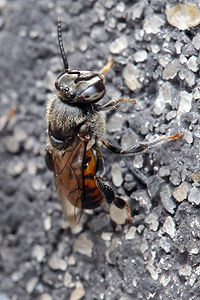
Photo from wikipedia
Abstract Growth in the global development of cities, and increasing public interest in beekeeping, has led to increase in the numbers of urban apiaries. Towns and cities can provide an… Click to show full abstract
Abstract Growth in the global development of cities, and increasing public interest in beekeeping, has led to increase in the numbers of urban apiaries. Towns and cities can provide an excellent diet for managed bees, with a diverse range of nectar and pollen available throughout a long flowering season, and are often more ecologically diverse than the surrounding rural environments. Accessible urban honeybee hives are a valuable research resource to gain insights into the diet and ecology of wild pollinators in urban settings. We used DNA metabarcoding of the rbcL and ITS2 gene regions to characterize the pollen community in Apis mellifera honey, inferring the floral diet, from 14 hives across an urban gradient around Greater Manchester, UK. We found that the proportion of urban land around a hive is significantly associated with an increase in the diversity of plants foraged and that invasive and non‐native plants appear to play a critical role in the sustenance of urban bees, alongside native plant species. The proportion of improved grassland, typical of suburban lawns and livestock farms, is significantly associated with decreases in the diversity of plant pollen found in honey samples. These findings are relevant to urban landscape developers motivated to encourage biodiversity and bee persistence, in line with global bio‐food security agendas.
Journal Title: Ecology and Evolution
Year Published: 2022
Link to full text (if available)
Share on Social Media: Sign Up to like & get
recommendations!